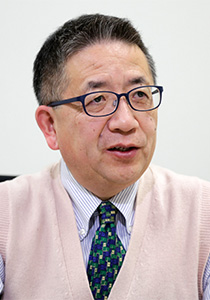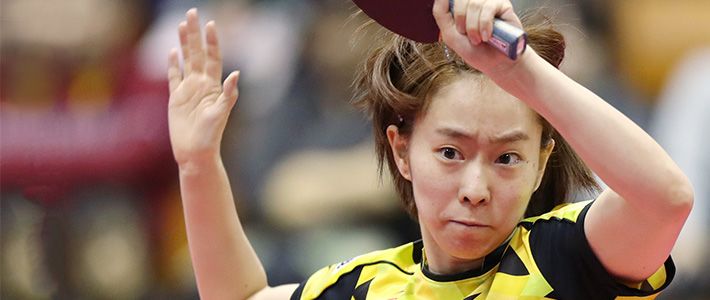
Fresh Faces at the Table:A Top Table Tennis Official on Japan’s Strong Young Squad
Society Sports- English
- 日本語
- 简体字
- 繁體字
- Français
- Español
- العربية
- Русский
Young players are shaking up Japan’s table tennis world with dazzling successes in international competition. Hirano Miu became the first Japanese winner of the Table Tennis World Cup women’s singles in October 2016 at the age of just 16. In the June 2017 World Table Tennis Championships in Düsseldorf, a youthful team raked in the most medals for Japan in 42 years, coming away with one gold, one silver, and three bronzes. And at 13, Harimoto Tomokazu became the youngest-ever quarterfinalist in the men’s singles competition.
As of January 2018, Japan has three representatives in the International Table Tennis Federation’s women’s top 10 world ranking. Ishikawa Kasumi (24), in fourth place, is ahead of two 17-year-olds, Itō Mima and Hirano Miu, in fifth and sixth, respectively. Hayata Hina, also 17, is just outside the top 10 in eleventh position.
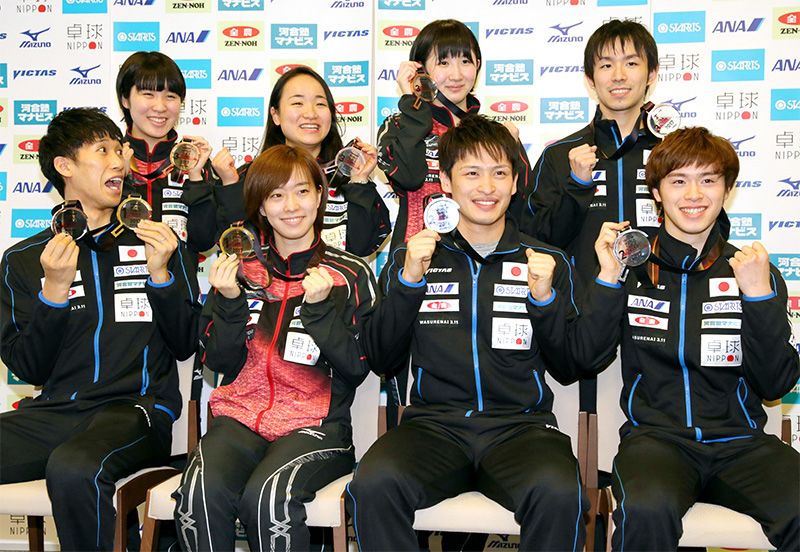 Japan’s players line up with their medals at Narita Airport on June 7, 2017, after returning from the World Table Tennis Championships in Germany. Back row (from left): Hirano Miu, Itō Mima, Hayata Hina, and Niwa Kōki; at front, Yoshimura Maharu, Ishikawa Kasumi, Ōshima Yūya, and Morizono Masataka. (© Jiji)
Japan’s players line up with their medals at Narita Airport on June 7, 2017, after returning from the World Table Tennis Championships in Germany. Back row (from left): Hirano Miu, Itō Mima, Hayata Hina, and Niwa Kōki; at front, Yoshimura Maharu, Ishikawa Kasumi, Ōshima Yūya, and Morizono Masataka. (© Jiji)
Taking the Long View
Japan is finally enjoying the limelight, having struggled on the international stage for many years. Ogimura Ichirō—winner of 12 World Championships gold medals in the 1950s and 1960s—established a national table tennis championship for elementary school students in 1981. “But up to 2000, only two of the winners of that competition went on to take part in singles events at the Olympics. Coaches focused too much on taking the immediate prize of the national tournament, rather than looking ahead to international competition,” says Maehara Masahiro, vice president of the Japan Table Tennis Association. “As international play moved on, Japan was no longer competitive. There were few coaches able to provide instruction on how to prevail against world-level opposition.”
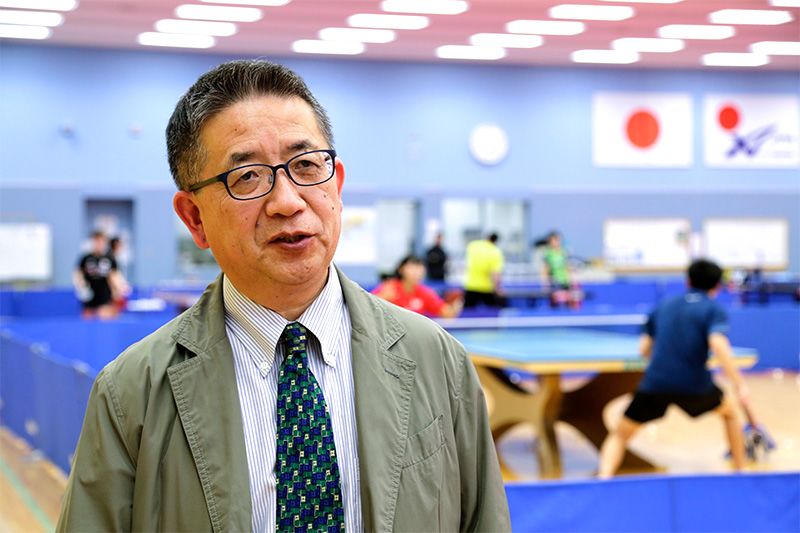 Maehara Masahiro at the Ajinomoto National Training Center in Tokyo. Japan Olympic Committee Elite Academy players practice in the background. (Photograph by Nagasaka Yoshiki)
Maehara Masahiro at the Ajinomoto National Training Center in Tokyo. Japan Olympic Committee Elite Academy players practice in the background. (Photograph by Nagasaka Yoshiki)
As the national head coach, Maehara took charge of creating a program to cultivate young players in October 2001. “There was a pressing need to hold training camps for elementary school students and develop young players with the technique and mindset to win in international competition.”
The national tournament was divided into three levels, with under-twelves known as Hopes, under-tens as Cubs, and under-eights as Bambini. Around 20–24 of the top players and those with potential were selected for annual three-day training camps. In an unusual situation for such camps, the coaches and parents or guardians of the Hopes were also invited to attend the gatherings, learning more about what high-level competition and training entailed.
At the same time, the national program launched a Hopes national team of elementary school students for international competition.
All-Round Development
“The Hopes national team needs four things: world-class technique and physical, mental, and nutrition training to match the players’ growth and development levels,” says Maehara.
“To compete internationally, they need to be equally capable of backhand and forehand play. Mentally, they have to move on from simply snapping when things don’t go their way and develop the ability to endure adversity and maintain presence of mind. We also instruct children who only tend to pick the foods they like at buffets during training camps and trips, teaching them the importance of choosing food that supplies extra nutrition or balance when they’re tired. And there’s even training that gets them to explain in front of everyone the reasons for their food selection, which boosts their presentation skills.”
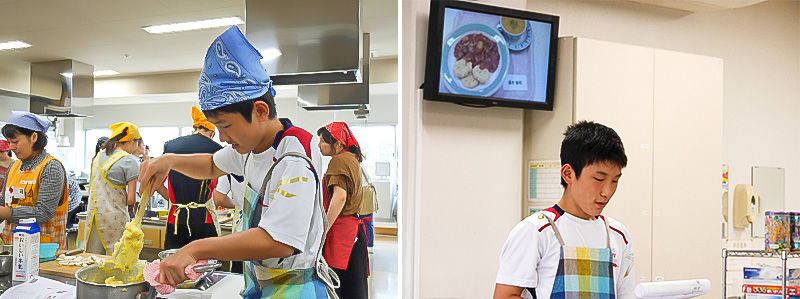 A cooking class focusing on international dishes (left). Harimoto Tomokazu talks about the South African “pap” porridge that he prepared. (Photograph courtesy Japan Table Tennis Association)
A cooking class focusing on international dishes (left). Harimoto Tomokazu talks about the South African “pap” porridge that he prepared. (Photograph courtesy Japan Table Tennis Association)
“We’ve also held classes assembling coaches from the strong schools during the national competition, aiming to improve the level of technique by sharing video footage of international matches. At first, some coaches stayed away, thinking it was just a waste of time.” As the classes continued, though, notes Maehara, people started to see them as a way of getting hold of useful information.
“Video makes everything easy to understand,” says Maehara, who always carries a camera with him. “I’ve done that since I was a player and a coach. When I saw players with a new way of serving in China, say, or Sweden, I’d immediately get it on video for analysis—even back in the day when cameras were still heavy and bulky.”
As well as recording the action, Maehara has taken photographs of negative things to warn his elementary and junior high school charges about, such as the mountains of forgotten belongings left behind after competitions. He has also used footage of bad behavior during matches to instruct players about good conduct.
It took around five years for the program to start showing results, and it has continued to move forward since. In the 2016 Olympics in Rio de Janeiro, Mizutani Jun became the first Japanese individual table tennis medalist, winning bronze in the men’s singles. He was 28 at the time and had been a member of the Hopes team in 2002. Ishikawa Kasumi, today Japan’s top women’s star, also first came to prominence in the Hopes.
In 2008, a National Training Center was established in Kita, Tokyo. A new initiative placed promising young athletes in nearby junior high schools, enabling them to attend the Japanese Olympic Committee Elite Academy all year round.
No effort is spared in training the potential stars to world-class level. The young table tennis players are even shown video footage of Japanese national soccer team members appealing to the referee in English to demonstrate the importance of being able to make a similar appeal in international competition.
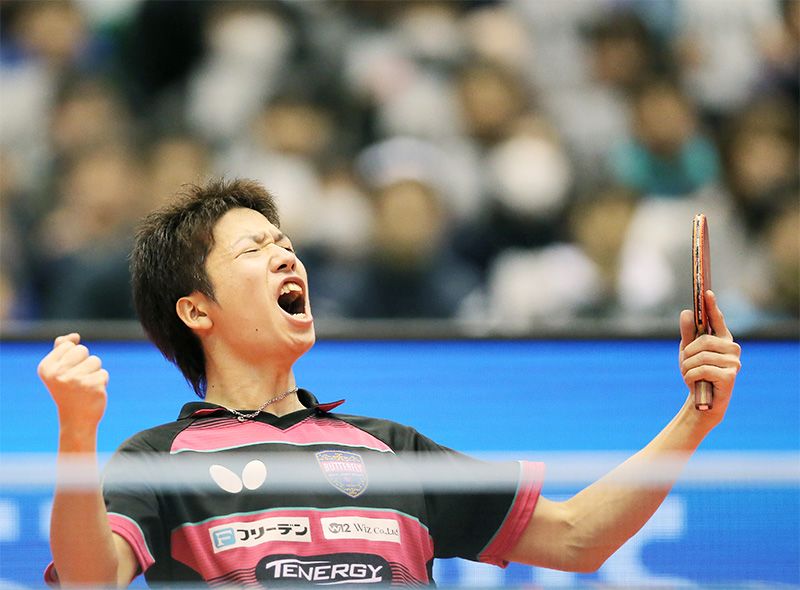 Mizutani Jun wins his ninth men’s singles title at the All Japan Championships on January 22, 2017, setting an all-time record. (© Jiji)
Mizutani Jun wins his ninth men’s singles title at the All Japan Championships on January 22, 2017, setting an all-time record. (© Jiji)
Bringing the Action Closer
“In 2004, Fukuhara Ai’s breakthrough success brought new interest to the sport, but we didn’t even have official posters to advertise the All Japan Table Tennis Championships. Unfortunately, there was nothing appealing about how matches, award ceremonies, and events were presented.”
Maehara suggested making changes to boost public awareness of table tennis. To bolster his arguments, he even visited the Nippon Budōkan to watch K-1 martial arts matches together with a competition organizer. “We were watching from the highest level of seating, looking down on the central ring like a matchbox below, but I could clearly hear the sounds of the fight. ‘Thud! Thud! Crash!’ It felt extraordinarily close to the action. Then I realized that the sounds were coming from speakers behind us.”
Later, Maehara had directional microphones installed under table tennis tables, carrying out his own sound checks to make sure that the speakers could be heard from the audience. This and other changes greatly improved the atmosphere of competitions. “Nothing ventured, nothing gained,” is Maehara’s motto.
Membership of the Japan Table Tennis Association has risen by 75,000 from 258,000 in 2002 to 333,000 in 2016. Around half of its current members are junior high school students. The increase in young players has raised the overall standard.
In the autumn of 2018, there are plans to launch a professional table tennis T. League, named to call to mind soccer’s J. League. What kind of showing will Japan’s players make in the 2020 Tokyo Olympics? Maehara says, “I want to get gold somehow. The players have also set their sights on winning.”
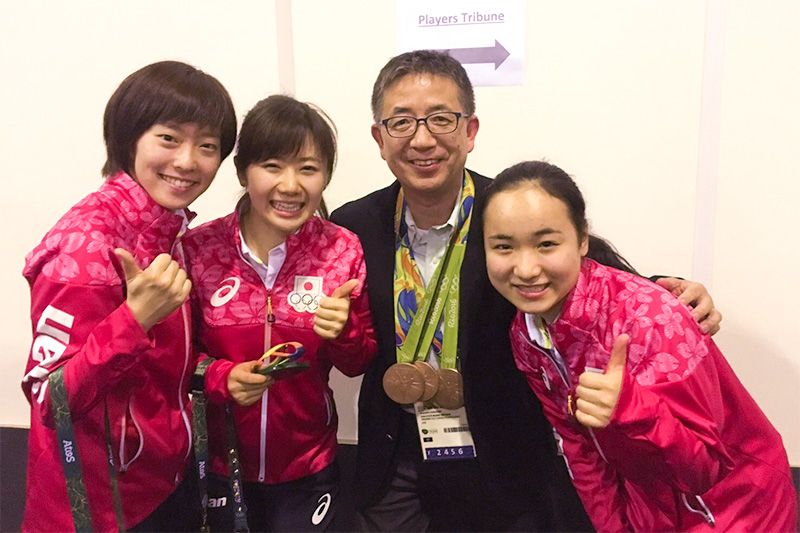 Maehara with the bronze-medal-winning women’s team at the 2016 Rio de Janeiro Olympics. From left to right: Ishikawa Kasumi, Fukuhara Ai, Maehara, and Itō Mima. (Photograph courtesy Japan Table Tennis Association)
Maehara with the bronze-medal-winning women’s team at the 2016 Rio de Janeiro Olympics. From left to right: Ishikawa Kasumi, Fukuhara Ai, Maehara, and Itō Mima. (Photograph courtesy Japan Table Tennis Association)
(Originally written in Japanese and published on January 12, 2018. Banner photo: Ishikawa Kasumi competes in the women’s singles at the Japan Top 12 table tennis competition in Tokyo on March 4, 2017. Ishikawa went on to win the tournament. © Jiji.)
